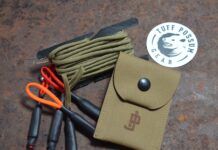One of the most pervasive bad ideas in the firearms community is the idea that there are different kinds of shooting. “Range shooting vs real world shooting” is a comparison that is brought up often, but the problem is that it’s incorrect. Today we’re taking a look at the myth of tactical shooting.
Why do we even say that there is a myth of tactical shooting? Because it’s founded in the idea that somehow people shoot their guns differently when they’re in a life or death situation vs when they’re on a range training. The truth is far from that. When you shoot a gun, regardless of the environment, two things are happening. The first the physical act of shooting, which consists of aligning the sights, pressing the trigger, and managing recoil. Those are three factors are influenced by grip and stance, and together make up the complete athletic act of shooting. The second category is environment – what’s going on around us. “Environment” in this application means everything but the act of shooting, so it includes weather, your physical condition, the situation that you’re in, etc.
Confusing environmental factors for shooting factors is what created the myth of tactical shooting. The act of lining up your sights, pressing the trigger, and managing recoil is exactly the same if you’re shooting a 3×5 card at 7 yards as it is if you were shooting an axe-wielding psychopath in the face at 7 yards. That hasn’t changed, but what has changed is your environment. In the latter situation, your stress level is going to be jacked through the roof, and stress will rapidly degrade your ability to perform the act of shooting.
The myth of tactical shooting originated from people trying to create training scenarios to manage stress. Think of your brain during a stressful situation like a computer. If it’s devoting 50% of its computing power to the act of shooting to get optimal performance, it can only devote 50% of its power to the real world situation in front of you. However, if you’ve trained to become a proficient marksman, your brain can devote say…25% of its power to the act of shooting, leaving 75% to manage the “tactical” situation in front of you.
We accomplish this goal by two types of training. First is marksmanship training. The better we are at shooting, the fewer resources our brain needs to carry out the act of shooting when we need to do it. The second type of training is stress inoculation. Essentially, we want to use environments like competition shooting or quality force-on-force training to vaccinate our brains against stress, so that when we’re in an actual life or death situation, we have a level of familiarity with stress. This keeps us from falling apart, and mirrors the methods the US military has been using for years to train people for combat.
So when we say “the myth of tactical shooting” what we really mean is this: shooting is shooting. We prepare to solve shooting problems by training for those, and we prepare for the different environments we may encounter by vaccinating ourselves against stress by inducing stressful scenarios. But how to shoot a gun doesn’t change.



